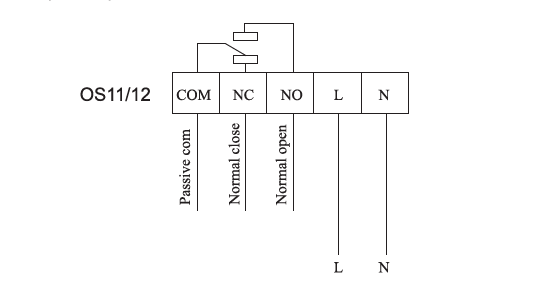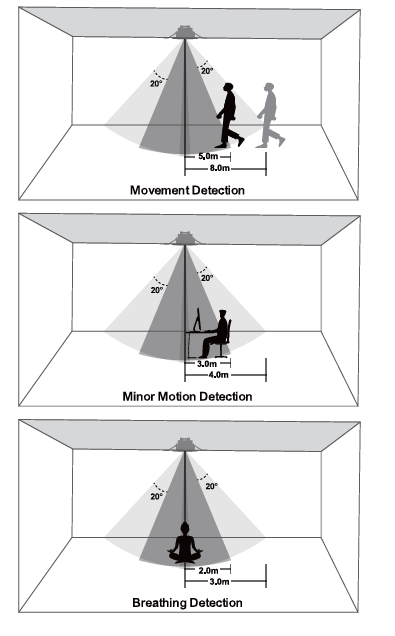Quickstart
This is a
Important safety information
Please read this manual carefully. Failure to follow the recommendations in this manual may be dangerous or may violate the law. The manufacturer, importer, distributor and seller shall not be liable for any loss or damage resulting from failure to comply with the instructions in this manual or any other material. Use this equipment only for its intended purpose. Follow the disposal instructions. Do not dispose of electronic equipment or batteries in a fire or near open heat sources.What is Z-Wave?
Z-Wave is the international wireless protocol for communication in the Smart Home. This device is suited for use in the region mentioned in the Quickstart section.
Z-Wave ensures a reliable communication by reconfirming every message (two-way communication) and every mains powered node can act as a repeater for other nodes (meshed network) in case the receiver is not in direct wireless range of the transmitter.
This device and every other certified Z-Wave device can be used together with any other certified Z-Wave device regardless of brand and origin as long as both are suited for the same frequency range.
If a device supports secure communication it will communicate with other devices secure as long as this device provides the same or a higher level of security. Otherwise it will automatically turn into a lower level of security to maintain backward compatibility.
For more information about Z-Wave technology, devices, white papers etc. please refer to www.z-wave.info.
Product Description
MCO Home OS11 is an advanced ceiling-mounted occupancy sensor based on 24?GHz Doppler radar technology. Unlike traditional PIR sensors, it can detect not only large movements but also subtle micro-movements such as breathing – making it ideal for precise automation in smart homes and professional buildings.
With support for the Z-Wave 800 series and S2 security encryption, the sensor integrates easily into modern smart home systems. It responds quickly and reliably, even when room activity is minimal.
Prepare for Installation / Reset
Please read the user manual before installing the product.
In order to include (add) a Z-Wave device to a network it must be in factory default state. Please make sure to reset the device into factory default. You can do this by performing an Exclusion operation as described below in the manual. Every Z-Wave controller is able to perform this operation however it is recommended to use the primary controller of the previous network to make sure the very device is excluded properly from this network.
Reset to factory default
This device also allows to be reset without any involvement of a Z-Wave controller. This procedure should only be used when the primary controller is inoperable.
To reset the device, use the exclusion function.
Safety Warning for Mains Powered Devices
ATTENTION: only authorized technicians under consideration of the country-specific installation guidelines/norms may do works with mains power. Prior to the assembly of the product, the voltage network has to be switched off and ensured against re-switching.
Installation
Wiring
Legend:
- L ... Life
- N ... Neutral
- COM ... Input Life
- NC ... Normal close
- NO ... Normal open
Inclusion/Exclusion
On factory default the device does not belong to any Z-Wave network. The device needs to be added to an existing wireless network to communicate with the devices of this network. This process is called Inclusion.
Devices can also be removed from a network. This process is called Exclusion. Both processes are initiated by the primary controller of the Z-Wave network. This controller is turned into exclusion respective inclusion mode. Inclusion and Exclusion is then performed doing a special manual action right on the device.
Inclusion
- 3 clicks the button in quick succession, the LED indicator will keep flashing and the device enter in learning mode.
Exclusion
- 3 clicks the button in quick succession, the LED indicator will keep flashing and the device enter in learning mode.
Product Usage
Local OperationShort press the button will switch the relay output on/off status. If the sensor has been added to the Z-Wave gateway, the sensor will automatically report the occupancy status to the Z-Wave gateway.
When motion is detected:
- LED indicator flashes once by default, this function can be enabled or disabled by setting the configuration parameters.
- Terminal COM is closed with NO and disconnected from NC. If no movement, minor motion, breathing is detected during the time setting of parameter 5, the device will switch to ‘unoccupied’ status, send notification_report command to the Z-Wave gateway to report State Idle, terminal COM will be disconnected from NO and closes with NC. If movement, minor motion, breathing is detected again during the delay process, the delay will be re-counted again.
If the sensor detects motion, status will change to ‘occupied’, LED indicator flashes once and terminal COM is closed with NO and disconnected from NC, it will also send notification_report command to the Z-Wave gateway to report Motion Detected.
Note: Breath detection is effective only when it is set at least 30 sec (please refer to parameter 5). It is recommended that the minor motion detection is set at least 10 sec.
Detection Pattern (OS11 detection probe angle can be adjusted up to 20° with more flexible installation design).


Quick trouble shooting
Here are a few hints for network installation if things dont work as expected.
- Make sure a device is in factory reset state before including. In doubt exclude before include.
- If inclusion still fails, check if both devices use the same frequency.
- Remove all dead devices from associations. Otherwise you will see severe delays.
- Never use sleeping battery devices without a central controller.
- Dont poll FLIRS devices.
- Make sure to have enough mains powered device to benefit from the meshing
Association - one device controls an other device
Z-Wave devices control other Z-Wave devices. The relationship between one device controlling another device is called association. In order to control a different device, the controlling device needs to maintain a list of devices that will receive controlling commands. These lists are called association groups and they are always related to certain events (e.g. button pressed, sensor triggers, ...). In case the event happens all devices stored in the respective association group will receive the same wireless command wireless command, typically a 'Basic Set' Command.
Association Groups:
| Group Number | Maximum Nodes | Description |
|---|---|---|
| 1 | 5 | Lifeline |
| 2 | 5 | Basic Set |
Configuration Parameters
Z-Wave products are supposed to work out of the box after inclusion, however certain configuration can adapt the function better to user needs or unlock further enhanced features.
IMPORTANT: Controllers may only allow configuring signed values. In order to set values in the range 128 ... 255 the value sent in the application shall be the desired value minus 256. For example: To set a parameter to 200 it may be needed to set a value of 200 minus 256 = minus 56. In case of a two byte value the same logic applies: Values greater than 32768 may needed to be given as negative values too.
Parameter 1: Detection Range
Maximum detection range (0–4 m). Values: 85–100: 7.3–8.4 m; 51–84: 5.2–7.2 m; 41–50: 2.0 m; <40: <1.5 m (small movements) Size: 1 Byte, Default Value: 100
| Setting | Description |
|---|---|
| 0 - 100 | Range mapping |
Parameter 2: LED Indicator
Size: 1 Byte, Default Value: 1
| Setting | Description |
|---|---|
| 0 | Disabled |
Parameter 3: Minor Motion Detection
Size: 1 Byte, Default Value: 1
| Setting | Description |
|---|---|
| 0 | Disabled |
| 1 | Enabled |
Parameter 5: Delay Timer Setting
Closes circuit with timer on motion, small motion or breathing. Valid only if parameter 9 is disabled. Breathing detection from 10 s. Recommendation: small motion ≥10 s. Size: 1 Byte, Default Value: 30
| Setting | Description |
|---|---|
| 2 - 7200 | Seconds |
Parameter 6: Switch Report Command
Basic Report / Switch Binary Report Size: 1 Byte, Default Value: 01
| Setting | Description |
|---|---|
| 0 | Basic Report |
| 1 | Switch Binary Report |
Parameter 7: Switch Output Control
Size: 1 Byte, Default Value: 01
| Setting | Description |
|---|---|
| 0 | Only controlled via gateway commands. |
| 1 | COM and NO close on motion, COM and NC on no motion. |
Parameter 8: Detection Sensitivity
Size: 1 Byte, Default Value: 2
| Setting | Description |
|---|---|
| 0 | Low |
| 1 | Medium |
| 2 | High |
Parameter 9: Away Mode Detection
Size: 1 Byte, Default Value: 0
| Setting | Description |
|---|---|
| 0 | Disabled |
| 1 | Enabled (15 s delay on absence) |
Parameter 20: Environmental Learning
Size: 1 Byte, Default Value: 0
| Setting | Description |
|---|---|
| 0 | Disabled |
| 1 | Start learning |
| 2 | Learning complete |
| 3 | Internal learning. Duration: 15 min, no person within 5 m. LED blinks during process. |
Parameter 21: Restore Factory Settings
Size: 1 Byte, Default Value: 01
| Setting | Description |
|---|---|
| 0 | Disabled |
| 1 | Reset sensor to factory settings |
Parameter 22: Blocking Time
Sensor inactive, LED blinks. Returns to normal after countdown. Size: 2 Byte, Default Value: 0
| Setting | Description |
|---|---|
| 0 - 14400 | Second |
Parameter 23: LED Blinking
Used to locate device. Size: - Byte, Default Value: 0
| Setting | Description |
|---|---|
| 0 - 300 | Seconds |
Parameter 255: Write Only
Size: 1 Byte, Default Value: 0
| Setting | Description |
|---|---|
| 0 | Disabled |
| 85 | Facotry Reset |
Technical Data
| Dimensions | 85 x 85 x 41 mm |
| Weight | 66 gr |
| Hardware Platform | ZG23 (800 Series) |
| EAN | 6928954281006 |
| IP Class | IP IP20 |
| Voltage | 230V |
| Load | 3A |
| Firmware Version | 03.01 |
| Z-Wave Version | 07.12 |
| Z-Wave Product Id | 015f.8101.0911 |
| Frequency | Europe - 868,4 Mhz |
| Maximum transmission power | 5 mW |
Supported Command Classes
- Basic
- Switch Binary
- Transport Service
- Association Grp Info
- Device Reset Locally
- Zwaveplus Info
- Supervision
- Configuration
- Alarm
- Manufacturer Specific
- Powerlevel
- Firmware Update Md
- Association
- Version
- Multi Channel Association
- Security 2
Explanation of Z-Wave specific terms
- Controller — is a Z-Wave device with capabilities to manage the network. Controllers are typically Gateways,Remote Controls or battery operated wall controllers.
- Slave — is a Z-Wave device without capabilities to manage the network. Slaves can be sensors, actuators and even remote controls.
- Primary Controller — is the central organizer of the network. It must be a controller. There can be only one primary controller in a Z-Wave network.
- Inclusion — is the process of adding new Z-Wave devices into a network.
- Exclusion — is the process of removing Z-Wave devices from the network.
- Association — is a control relationship between a controlling device and a controlled device.
- Wakeup Notification — is a special wireless message issued by a Z-Wave device to announces that is able to communicate.
- Node Information Frame — is a special wireless message issued by a Z-Wave device to announce its capabilities and functions.

